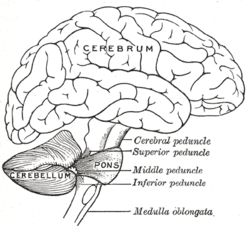Dyschronometria
| Cerebellum | |
|---|---|

A human brain, with the cerebellum colored in purple
|
|

Drawing of the human brain, showing cerebellum and pons
|
|
| Details | |
| Part of | Metencephalon |
| Artery | SCA, AICA, PICA |
| Vein | superior, inferior |
| Identifiers | |
| NeuroLex ID | Cerebellum |
|
Anatomical terms of neuroanatomy
[]
|
|
Dyschronometria is a condition of cerebellar dysfunction in which an individual cannot accurately estimate the amount of time that has passed (i.e., distorted time perception). It is associated with cerebellar ataxia, when the cerebellum has been damaged and does not function to its fullest ability. Lesions to the cerebellum can cause dyssynergia, dysmetria, dysdiadochokinesia, dysarthria, and ataxia of stance and gait. Dyschronometria can result from autosomal dominant cerebellar ataxia (ADCA).
Common signs of dyschronometria are often generic to cerebellar ataxia, including a lack of spatial awareness, poor short term memory, and inability to keep track of time. The defining symptoms, while not completely understood, involve time perception. For example, when asked to wait for thirty seconds, or tap every second that has gone by, those affected will be able to perform the task for a short time and then become derailed. This can result from a loss of focus, however, more often than not the individual affected can no longer tell what they are doing and become disoriented. This often takes form in forgetting basic time keeping unless a timer is set, such as when cooking for example. Dyschronometria does not affect the 24-hour circadian rhythm, which is sustained by a different biological process.
The most common cause of cerebellar ataxia, and by extension dyschronometria, is cerebellar damage. This can be by form of a trauma, or by disease and genetics. Examples of trauma include a car accident, stroke, epilepsy, and head trauma. These traumas are especially detrimental to elderly and children due to the decrease in brain matter, thus making these events if taken place have an increased risk of damaging the cerebellum. This also explains why dyschronometria is seen more commonly in the elderly due to the deterioration of physical brain matter. Other probable causes for the deterioration of brain matter in the elderly include increased supranational activation, decreased cerebellar activation (which is consistent with fronto-cerebellar dissociation).
...
Wikipedia
